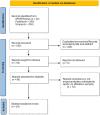Safeguarding Athletes Against Head Injuries Through Advances in Technology: A Scoping Review of the Uses of Machine Learning in the Management of Sports-Related Concussion
- PMID: 35520095
- PMCID: PMC9067303
- DOI: 10.3389/fspor.2022.837643
Safeguarding Athletes Against Head Injuries Through Advances in Technology: A Scoping Review of the Uses of Machine Learning in the Management of Sports-Related Concussion
Abstract
Sports injury prevention is an important part of the athlete welfare and safeguarding research field. In sports injury prevention, sport-related concussion (SRC) has proved to be one of the most difficult and complex injuries to manage in terms of prevention, diagnosis, classification, treatment and rehabilitation. SRC can cause long-term health issues and is a commonly reported injury in both adult and youth athletes around the world. Despite increased knowledge of the prevalence of SRC, very few tools are available for diagnosing SRC in athletic settings. Recent technological innovations have resulted in different machine learning and deep learning methodologies being tested to improve the management of this complex sports injury. The purpose of this article is to summarize and map the existing research literature on the use of machine learning in the management of SRC, ascertain where there are gaps in the existing research and identify recommendations for future research. This is explored through a scoping review. A systematic search in the three electronic databases SPORTDiscus, PubMed and Scopus identified an initial 522 studies, of which 24 were included in the final review, the majority of which focused on machine learning for the prediction and prevention of SRC (N = 10), or machine learning for the diagnosis and classification of SRC (N = 11). Only 3 studies explored machine learning approaches for the treatment and rehabilitation of SRC. A main finding is that current research highlights promising practical uses (e.g., more accurate and rapid injury assessment or return-to-sport participation criteria) of machine learning in the management of SRC. The review also revealed a narrow research focus in the existing literature. As current research is primarily conducted on male adolescents or adults from team sports in North America there is an urgent need to include wider demographics in more diverse samples and sports contexts in the machine learning algorithms. If research datasets continue to be based on narrow samples of athletes, the development of any new diagnostic and predictive tools for SRC emerging from this research will be at risk. Today, these risks appear to mainly affect the health and safety of female athletes.
Keywords: athlete welfare; deep learning; machine learning; sport and health; sport injury prevention; sport technologies; sports-related concussion (SRC).
Copyright © 2022 Tjønndal and Røsten.
Conflict of interest statement
The authors declare that the research was conducted in the absence of any commercial or financial relationships that could be construed as a potential conflict of interest.
Figures
Similar articles
-
American Medical Society for Sports Medicine position statement: concussion in sport.Br J Sports Med. 2013 Jan;47(1):15-26. doi: 10.1136/bjsports-2012-091941. Br J Sports Med. 2013. PMID: 23243113 Review.
-
Acute evaluation of sport-related concussion and implications for the Sport Concussion Assessment Tool (SCAT6) for adults, adolescents and children: a systematic review.Br J Sports Med. 2023 Jun;57(11):722-735. doi: 10.1136/bjsports-2022-106661. Br J Sports Med. 2023. PMID: 37316213
-
Quantitative Assessment of Balance for Accurate Prediction of Return to Sport From Sport-Related Concussion.Sports Health. 2022 Nov-Dec;14(6):875-884. doi: 10.1177/19417381211068817. Epub 2022 Feb 4. Sports Health. 2022. PMID: 35120415 Free PMC article.
-
History of Sport-Related Concussion and Long-Term Clinical Cognitive Health Outcomes in Retired Athletes: A Systematic Review.J Athl Train. 2020 Feb;55(2):132-158. doi: 10.4085/1062-6050-297-18. Epub 2020 Jan 14. J Athl Train. 2020. PMID: 31935139 Free PMC article.
-
What the research says about concussion risk factors and prevention strategies for youth sports: A scoping review of six commonly played sports.J Safety Res. 2019 Feb;68:157-172. doi: 10.1016/j.jsr.2018.11.005. Epub 2018 Dec 12. J Safety Res. 2019. PMID: 30876507 Free PMC article.
Cited by
-
Use of Brain Biomechanical Models for Monitoring Impact Exposure in Contact Sports.Ann Biomed Eng. 2022 Nov;50(11):1389-1408. doi: 10.1007/s10439-022-02999-w. Epub 2022 Jul 22. Ann Biomed Eng. 2022. PMID: 35867314 Free PMC article. Review.
-
Prevention of sports-related concussion in soccer: a comprehensive review of the literature.Ann Med Surg (Lond). 2023 Mar 24;85(3):365-373. doi: 10.1097/MS9.0000000000000268. eCollection 2023 Mar. Ann Med Surg (Lond). 2023. PMID: 37008175 Free PMC article.
References
-
- Agoston D. V.. (2019). “Big data, artificial intelligence, and machine learning in neurotrauma,” in Leveraging Biomedical and Healthcare Data. Semantics, Analytics and Knowledge, eds F. Kobeissy, A. Alawieh, F. A. Zaraket, and K. Wang (Kidlington: Elsevier Inc.) 53–75. 10.1016/B978-0-12-809556-0.00004-6 - DOI
-
- Arksey H., O'Malley L. (2005). Scoping studies: Towards a methodological framework. Int. J. Soc. Res. Methodol. 8, 19–32. 10.1080/1364557032000119616 - DOI
-
- Barker-Ruchti N., Schubring A., Stewart C. (2021). “Gendered violence in women's artistic gymnastics: a sociological analysis,” in Routledge Handbook of Athlete Welfare, ed M. Lang (Abingdon: Routledge). 10.4324/9780429201745-8 - DOI
Publication types
LinkOut - more resources
Full Text Sources
Research Materials
Miscellaneous


